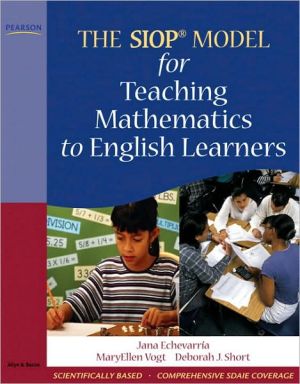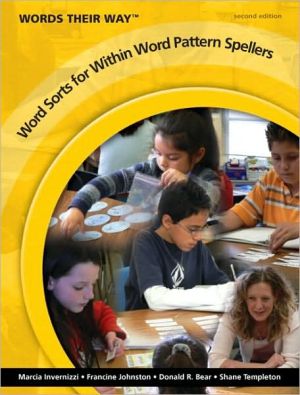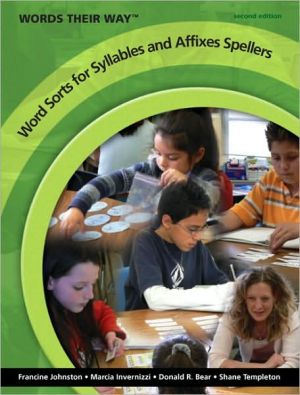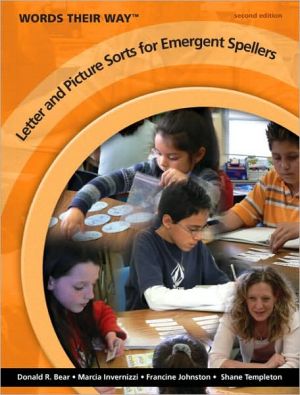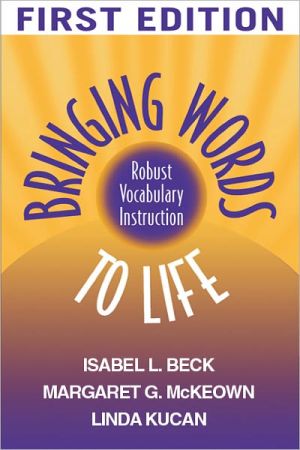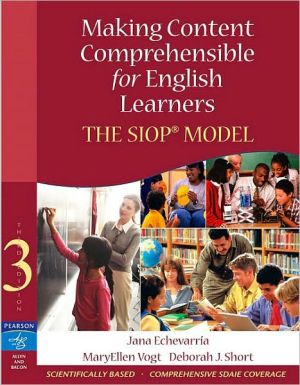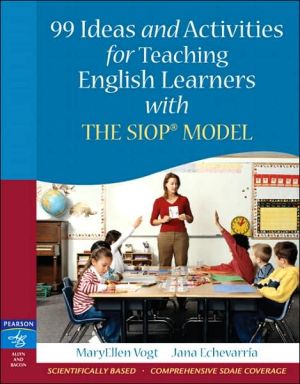The SIOP Model for Teaching Mathematics to English Learners
Based on the best-selling resource Making Content Comprehensible for English Learners: The SIOP® Model by acclaimed authors Jana Echevarria, MaryEllen Vogt, and Deborah Short, K-12 math teachers, coaches, and intervention specialists now have access to research-based, SIOP-tested techniques for lessons specifically for the mathematics classroom.\ In The SIOP® Model for Teaching Mathematics to English Learners SIOP® techniques, activities, sample lessons and complete units based on NCTM...
Search in google:
Enhance your Mathematics content instruction with the SIOP Model and transform the academic English and mathematics skills of your English learners.Based on the best-selling resource, Making Content Comprehensible for English Learners: The SIOP Model by acclaimed authors Jana Echevarria, MaryEllen Vogt, and Deborah Short; teachers, coaches, and intervention teachers have access to research-based, SIOP-tested techniques for lessons specifically for the mathematics classroom. This highly anticipated book, The SIOP Model for Teaching Mathematics to English Learners addresses the issues faced in teaching math to English learners (ELs) at each grade-level. SIOP techniques and activities organized around the eight SIOP components guide educators in promoting academic language development along with comprehensible mathematics content.Written for SIOP teachers and those who have learned the SIOP Model, this book includes proven, effective math lessons and comprehensive units designed by SIOP math educators Araceli Avila and Melissa Castillo. In addition, this book provides ideas to adapt the techniques for students at different levels of English proficiency. This book is sure to become an indispensable resource for math educators of English learners. Presents a systematic process for teaching both the academic content of mathematics and its associated academic language to English learners. Offers ideas and activities about teaching mathematics and organizes activities by grade-bands—K-2, 3-5 (or 6), 6-8, and 9-12 and SIOP components. Provides use-tomorrow ideas and activities for implementing the eight components of the SIOP Model in a mathematics classroom. Includes lesson plans and comprehensive units that illustrate how a particular activity can be effective for ALL students, not just English learners. Create the ideal SIOP classroom with other resourcesfrom the SIOP Model Series: 99 Ideas and Activities for Teaching English Learners with the SIOP Model; Implementing the SIOP Model through Effective Coaching and Professional Development; The SIOP Model for Administrators; Making Content Comprehensible for Elementary English Learners; and Making Content Comprehensible for Secondary English Learners; The SIOP Model for Teaching Math to English Learners; The SIOP Model for Teaching Social Studies to English Learners; and The SIOP Model for Teaching Science to English Learners (all published by Pearson)
TABLE OF CONTENTSPREFACE AND ACKNOWLEDGEMENTSChapter 1: Introduction and Review of the SIOP MODELChapter 2: The Academic Language of MathematicsChapter 3: Activities and Techniques for Planning SIOP Mathematics LessonsChapter 4: Lesson and Unit Design for SIOP Mathematics LessonsChapter 5: Pulling It All TogetherAppendix A: SIOP Model Components and FeaturesChapter 1 INTRODUCTION AND REVIEW OF THE SIOP MODELKey Components of the SIOP Model1. Lesson Preparation2. Building Background3. Comprehensible Input4. Strategies5. Interaction6. Practice & Application7. Lesson Delivery8. Review & AssessmentWhy Is the SIOP Needed Now?Organization and Purpose of This BookCHAPTER 2 THE ACADEMIC LANGUAGE OF MATHEMATICSWhat is Academic Language?How Does Academic Language Fit Into the SIOP Model?How Is Academic Language Manifested in Classroom Discourse?Why Do English Learners Have Difficulty with Academic Language?How Can We Effectively Teach Academic Language In Mathematics?The Role of Discussion and Conversation in Developing Academic LanguageWhat is the Academic Language of Mathematics?In SummaryAppendix B Academic Math Vocabulary Based on NCTM Content and Process StandardsCHAPTER 3 ACTIVITIES AND TECHNIQUES FOR PLANNING SIOP MATHEMATICSLESSONS By Araceli Avila and Melissa CastilloIntroductionLesson Plan FormatMath Techniques and ActivitiesSIOP Math Techniques and Activities: Lesson PreparationNumber 1-3 for Self Assessment of ObjectivesSIOP Lesson PlanBLM 3.1 What Do You Know About Geometric Shapes?SIOP Math Techniques and Activities: Building Background4 Corners Vocabulary ChartKWL ChartSIOP Lesson PlanSIOP Math Techniques and Activities: Comprehensible InputMath Representations Graphic OrganizerBLM 3.2 Math Representations Graphic OrganizerSIOP Lesson PlanSIOP Math Techniques and Activities: StrategiesYou Are the TeacherSIOP Lesson PlanBLM 3.3 Let’s MeasureVocabulary AliveSIOP Lesson PlanSIOP Math Techniques and Activities: InteractionConga LineGroup Responses with a White BoardSIOP Lesson PlanFind Your MatchSIOP Math Techniques and Activities: Practice & ApplicationBingoSIOP Math Techniques and Activities: Review & AssessmentFind Someone WhoSIOP Lesson PlanBLM 3.4 Colored TrianglesIn SummaryCHAPTER 4 LESSON AND UNIT DESIGN FOR SIOP MATHEMATICS LESSONSBy Araceli Avila and Melissa CastilloIntroductionMath unit-grades k-2Overview of the unitSIOP Planning Flow ChartSIOP Lesson Plan-Day 1BLM 1.1 Vocabulary Activity SheetSIOP Lesson Plan-Days 2-3BLM 2.1 Let’s Measure the Length of…SIOP Lesson Plan-Day 4BLM 4.1 Measuring Length and DistanceSIOP Lesson Plan-Day 5Math Unit-Grades 3-5Overview of the unitSIOP Planning Flow ChartSIOP Lesson Plan-Day 1BLM 1.1 4-Corners Vocabulary Activity SheetBLM 1.2 Shape CharacteristicsSIOP Lesson Plan-Days 2BLM 2.1 Colored TrianglesSIOP Lesson Plan-Day 3-4SIOP Lesson Plan-Day 5Math Unit-Grades 6-8Overview of the unitSIOP Planning Flow ChartSIOP Lesson Plan-Day 1-2BLM 1.1 Integer Dollar CardsBLM 2.1 Lab SheetBLM 2.2 Instruction for Who is Colder? Card GameSIOP Lesson Plan-Days 3BLM 3.1 Integers Venn DiagramBLM 3.2 Weather News TransparencyBLM 3.3 Adding Integers Lab SheetBLM 3.4 Simultaneous Round Table Activity SheetSIOP Lesson Plan-Day 4BLM 4.1 Subtracting Integers Lab SheetBLM 4.2 Fun With Integers InstructionsBLM 4.3 Fun With Integers Recording SheetSIOP Lesson Plan-Day 5BLM 5.1 Where is The Submarine?BLM 5.2 Applying Integers Lab SheetMath Unit-Grades 9-12Overview of the UnitSIOP Planning Flow ChartSIOP Lesson Plan-Days 1-2BLM 1.1 Math Representations Graph OrganizerSIOP Lesson Plan-Day 3BLM 3.1 Tiling Squared PoolsBLM 3.2 Fencing GardensBLM 3.3 Layers GaloreBLM 3.4 Function MatrixSIOP Lesson Plan-Day 4BLM 4.1 Translating Parent Functions Lab SheetBLM 4.2 Ordered Pairs for Quadratic Parent FunctionBLM 4.3 Ordered Pairs for Linear Parent FunctionBLM 4.4 Ordered Pairs for Exponential Parent FunctionSIOP Lesson Plan-Day 5BLM 5.1 Go To Your Corner CardsBLM 5.2 Multiplying x by -1 < a < 0BLM 5.3 Multiplying x by 0 < a < 1BLM 5.4 Multiplying a by > 1BLM 5.5 Multiplying x by a < -1BLM 5.6 Multiplying x by -1BLM 5.7 Combining TransformationsSUMMARYREFERENCES
